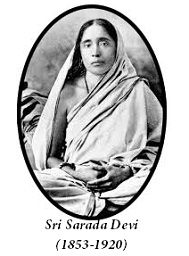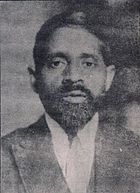Saradamani Devi—the nun-wife of Sri Ramakrishna and familiarly known as the Holy Mother—was born in 1853 at a village called Jayrambati not very far from Kamarpukur, the birth-place of Sri Ramakrishna. Though Sri Ramakrishna lived constantly on a high spiritual plane, almost oblivious of his surroundings, he consented to his marriage. It was, however, out of the question for him to live a married life: his mind always soaring high, any worldly thought was excruciating pain to him. Pure as purity itself Saradamani also had no desire for a life of worldliness. She sympathised with the aspirations of her husband and became a help to him in his spiritual pursuits. All that she wanted was to have the privilege of serving him. That favour she was given in abundance. Sri Ramakrishna, for his part, was extremely considerate to Saradamani. He gave her the best spiritual training and once clearly hinted that his mantle would fall on her and that she would have to fulfil a spiritual mission. He looked upon her as the veritable manifestation of the Divine Mother, and once actually worshipped her as such.
During the last few years of the life of Sri Ramakrishna, Saradamani often lived at Dakshineswar and later at Shyampukur and Cossipore where Sri Ramakrishna was removed during his illness. During these years, although she hardly came out of her room or could be seen, her sweetness of character, loving heart and saintliness commanded such respect from the disciples and devotees of Sri Ramakrishna, that they all began to look upon her as their mother.
After the passing away of Sri Ramakrishna, she passed through a period of great suffering and hardship. But as her spiritual personality unfolded itself more and more, people began to flock to her in larger numbers for spiritual refuge and shelter. She transformed many lives and brought solace and comfort to hundreds of weary souls. It was a rare privilege to come under her spiritual influence, and people thought it a blessed opportunity to serve her in however slight a measure. But she would hardly take any service from anybody ; on the contrary she would, just like a mother, look after the comforts of all who came in contact with her. During the later days she lived partly in Calcutta and partly at her parental home at Jayrambati. In spite of the fact that she belonged to a high spiritual plane, she could and would do all the household work just like an ordinary woman of the village. This simplicity of her life gave opportunities to many to mix with her without any awe or fear. But when one got even a faint glimpse of her real spiritual stature, one was overwhelmed.
In the Ramakrishna Order her place is next, if not equal, to that of the Master himself. Swami Viveka-nunda started for the West on his historic mission only when she gave her permission and blessings. Her word was final in all the important affairs of the Order, and her slightest wish was more than a sacred injunction to every individual. She was virtually the spiritual guide of the Mission as long as she was in her earthly existence. She passed away in 1920.

